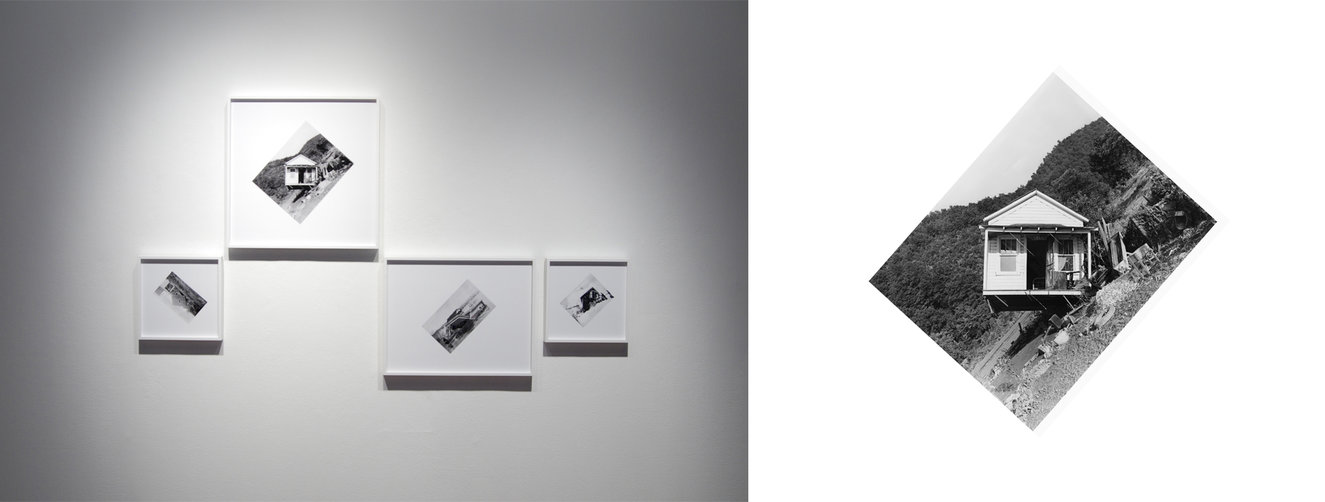 Kristie MacDonald, (Left to right) Tornado Views of Emporia Kansas, Morehead Kentucky Flash Flood, 22″ x 22″. Digital Print, 2013, Floating Down The Merrimac River Massachusetts, 22″ x 18″, Digital Print, Avalanche, Sigerfjord Norway, Morehead Kentucky Flash Flood (detail), 2013. C-print. Courtesy of the artist and Gallery 44
Kristie MacDonald, (Left to right) Tornado Views of Emporia Kansas, Morehead Kentucky Flash Flood, 22″ x 22″. Digital Print, 2013, Floating Down The Merrimac River Massachusetts, 22″ x 18″, Digital Print, Avalanche, Sigerfjord Norway, Morehead Kentucky Flash Flood (detail), 2013. C-print. Courtesy of the artist and Gallery 44
Gallery 44 began its 2014 exhibition lineup through an in-depth analysis and reflection of the past. What Was Will Be unites the work of Kristie MacDonald and Christina Battle, two artists that utilize the potential of the archive to present us with media installations based on natural disasters. The exhibition brings together MacDonald’s series Mechanisms for Correcting the Past and Battle’s dearfield, colorado. In a disconcerting manner, these unearthed documents carry a prophetic quality, as if ignored signs from the past that have resurfaced in our current context of global climate change. After encountering the devastating effects of the polar vortex and recent ice storm, the environmental themes raised by What Was Will Be rings incredibly close for Torontonians.
 Kristie MacDonald, Machine for Correcting the Past, 2013. Found image, Projector, Electronics, Table. Courtesy of the artist and Gallery 44
Kristie MacDonald, Machine for Correcting the Past, 2013. Found image, Projector, Electronics, Table. Courtesy of the artist and Gallery 44
Mechanisms for Correcting the Past appropriates decontextualized images of dilapidated structures in order to explore the parameters of historical and fictitious narratives. MacDonald utilizes a compulsive desire to reverse the relationship between landscape and subject by rotating images of buildings to straighten its base while skewing the horizon line of the surrounding environment. The images that Macdonald has chosen all contain scenes that pertain to the aftermath of natural disasters. Reoccurring scenes of floods, wreckage, and splinted wooden houses are presented as contextual moments that form a collective experience. Much like Andrew Wright’s Tree Corrections or the practice of Jan Dibbets, MacDonald experiments with attributing aesthetic order to nature’s chaos. However, aside from presenting an example of nature’s power, unity, and resurging triumph, MacDonald’s work possesses a slightly sombre tone that demonstrates the fragility of existence and why nature must be treated with caution. Through the process of recollecting and re-presenting, MacDonald predicts the impending future in relation to our global climate. By straightening the structures within these old images, the artist comments on humankind’s natural inclination to focus on matters which directly concern us. As Mechanisms for Correcting the Past demonstrates, the industrial desire to strive forward while ignoring past mistakes is a pattern that can prove to be most disastrous.
 Christina Battle, dearfield, colorado, still from media installation and installation view, 2013. Courtesy of the artist and Gallery 44.
Christina Battle, dearfield, colorado, still from media installation and installation view, 2013. Courtesy of the artist and Gallery 44.
In conjunction with MacDonald’s work, Christina Battle utilizes fragments of historical evidence in considering the ways that we formulate our understanding of history in a contemporary sphere. dearfield, colorado regales the tragic tale of the town for consideration. Founded in 1910 as an early African-American settlement, the town of Dearfield grew to a population of 700 inhabitants at its height in 1921. The word dear was chosen as the foundation for the town’s name due to the precious agricultural value of the land and the importance of community to the town’s settlers. Dearfield ultimately succumbed to the effects of drought during the Great Depression. By 1940 it was reduced to a population of 12 and is currently a ghost town. In dearfield, colorado, Battle pairs images of the town’s deserted and desolate buildings with quotes taken from first-hand accounts of dust storms. The constant hints at electricity refer to more than just the tension that filled the air, as more recent scientific evidence demonstrates that dust storms produce intense electrical fields. Battle choose to replicate this unique natural phenomenon by projecting the piece in a room covered with aluminum. As the video reflects off the surrounding walls and floor, metallic skies are mirrored in an artificial body of water, creating an eerily heavenly glow. In a sentimental style, dearfield, colorado pays homage to the town’s residents by granting their one wish for water and rain. Much like the Farm Administration Project’s efforts to humanize those most effected by the Depression, dearfield, colorado touches upon the importance of remembering history. As the dilapidated houses of the town are distorted on the surface of the aluminum, Battle illustrates how easily forgotten parts of history can dissipate within our industrialized world.
Shellie Zhang
* What Was Will Be runs till February 15th, 2014 at Gallery 44, 120-401 Richmond St W. Gallery hours: Tues – Sat 11 – 5 p.m.
